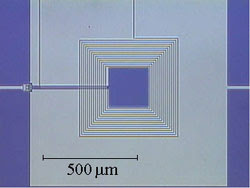Yesterday John Clarke (University of California, Berkeley) gave a nice
colloquium at UQ on Applications of SQUIDs (Superconducting Quantum Intereference Devices).
Clarke is arguably the "father" of the development of SQUIDs in both science and technology. Many of the people currently leading the development of superconducting qubits were at one time his students or postdocs. Tim Duty is to be thanked for bringing Clarke to UQ to give this fascinating talk.
The two key physical effects on which the SQUID
is based are Josephson tunneling and magnetic flux quantisation.
In a DC SQUID the I-V curve is modulated by magnetic flux, and so the device is basically a flux to voltage transducer with noise that can approach the quantum limit. They can detect magnetic fields as small as a femtotesla!

Roger Highfield's book, The Science of Harry Potter describes how the sorting hat that Harry used in the first book is based on SQUIDs. [When I told my son that, he said this is not correct because the hat is based on magic and that is the whole point!]
Clarke described two nice projects he has been involved in building highly sensitive detectors to answer fundamental questions in Cosmology.
The first involves the search for dark matter, specifically looking for clusters of galaxies, largest bound objects in the universe. This uses Sunyarev-Zeldovich effect involving shifts in the Cosmic Microwave Background because CMB photos are scattered by hot gas bound to clusters.
This invovles a Transition edge sensor which is limited by photon shot noise. 100 squid array, multiplexer, current summing circuit, comb of frequencies....
This is now installed at the South pole telescope.
The second project involves the search for cold dark matter, specifically the axion, a particle proposed in 1978 to explain the magnitude of the electric dipole moment of neutron, which is three orders of magnitude smaller than standard model predicts. [This was news to me. I thought the standard model explained everything!, more or less].
How can axions be detected? Primakoff conversion (Sikivie, 1983) of an axion to photon. I did not follow how this worked.
Noise temperature of amplifiers needs to be reduced. Want quieter ones than HEMTs (High electron mobility transistors (based on GaAs).
With SQUID noise temperature becomes about 30-40 times lower than HEMT.
Then the required measurement time decreased from 270 years to 100 days, so graduate students may be interested in working on this project!
Clarke then discussed Microtesla magnetic resonance imaging.
A standard clinical MRI machine uses 1.5 Tesla, costs 2$M, and you sometimes need to reinforce floor. Inspired by Michael Crichton novel (1999) to use earths magnetic field for imaging. [Was this tongue in cheek?]
Clarke showed results from a PNAS paper in 2004, which imaged a Red Pepper [capsicum to some?], with a resolution of 0.7mm. He also showed 3D images of arm with a field of 132 micro tesla. He went on to discuss T1 weighted contrast imaging (contrast agent is Gd salt). I then had to leave to go to my son's futsal game....
And to think that all this technology and science has come about because a young Ph.D student about 40 years ago was challenged to think about physical signatures of spontaneous symmetry breaking in superconductors....



Qubits and quantum interference devices with specifications on the scale of femtoteslas spell data density capable of forging progress in the refinement of the standard model of relative quantum mechanics. Valid research is now exploring the femtoscale horizon of electronic data, and has resolved the h-bar magnetic energy particle image of ~175 picoyoctometers.
ReplyDeleteRecent advancements in quantum science have produced the picoyoctometric, 3D, interactive video atomic model imaging function, in terms of chronons and spacons for exact, quantized, relativistic animation. This format returns clear numerical data for a full spectrum of variables. The atom's RQT (relative quantum topological) data point imaging function is built by combination of the relativistic Einstein-Lorenz transform functions for time, mass, and energy with the workon quantized electromagnetic wave equations for frequency and wavelength.
The atom labeled psi (Z) pulsates at the frequency {Nhu=e/h} by cycles of {e=m(c^2)} transformation of nuclear surface mass to forcons with joule values, followed by nuclear force absorption. This radiation process is limited only by spacetime boundaries of {Gravity-Time}, where gravity is the force binding space to psi, forming the GT integral atomic wavefunction. The expression is defined as the series expansion differential of nuclear output rates with quantum symmetry numbers assigned along the progression to give topology to the solutions.
Next, the correlation function for the manifold of internal heat capacity energy particle 3D functions is extracted by rearranging the total internal momentum function to the photon gain rule and integrating it for GT limits. This produces a series of 26 topological waveparticle functions of the five classes; {+Positron, Workon, Thermon, -Electromagneton, Magnemedon}, each the 3D data image of a type of energy intermedon of the 5/2 kT J internal energy cloud, accounting for all of them.
Those 26 energy data values intersect the sizes of the fundamental physical constants: h, h-bar, delta, nuclear magneton, beta magneton, k (series). They quantize atomic dynamics by acting as fulcrum particles. The result is the picoyoctometric, 3D, interactive video atomic model data point imaging function, responsive to keyboard input of virtual photon gain events by relativistic, quantized shifts of electron, force, and energy field states and positions.
Images of the h-bar magnetic energy waveparticle of ~175 picoyoctometers are available online at http://www.symmecon.com with the complete RQT atomic modeling manual titled The Crystalon Door, copyright TXu1-266-788. TCD conforms to the unopposed motion of disclosure in U.S. District (NM) Court of 04/02/2001 titled The Solution to the Equation of Schrodinger.